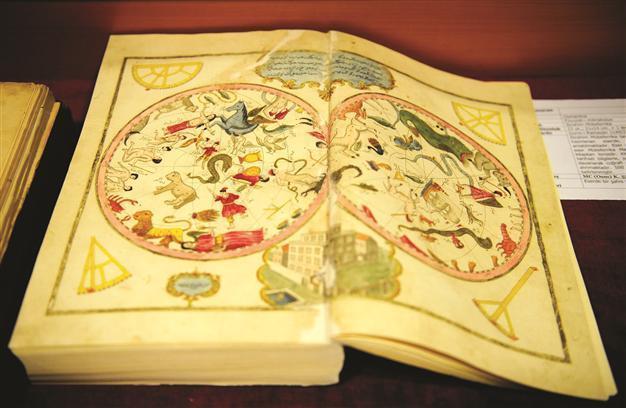Müteferrika books featured in library exhibit
ISTANBUL- Hürriyet Daily News

The photo left shows a portrait of İbrahim
Müteferrika. Sixteen unique works that have been published in his printing house are being displayed at the Atatğrk Library. AA photo
Sixteen works printed by the founder of Turkish printing, İbrahim Müteferrika, typically available only to researchers by special permission, are currently being displayed at Istanbul’s Atatürk Library.
“The İbrahim Müteferrika Printing House: an exhibition on the 285th anniversary of its establishment” displays 16 of the 17 works printed at the Müteferrika Printing House. The exhibition will give researchers, students, and the curious an opportunity to examine all of the books together through Sept. 27.
İbrahim Müteferrika is known as the first person to use movable type to print Arabic script, working under the auspices of the Ottoman Empire. The works printed at the Müteferrika Printing House include an Arabic-Ottoman dictionary, “Vankulu Lugatı,” which was the first book printed there, and “Tarih-i Hind-i Garbi, el müsemma bi-Hadis-i nev,” which tells about the discovery of America, as well as an early picture book and a grammar book using the Latin alphabet, designed to teach Ottoman Turkish to the French. The goal of the current exhibition is to enable people to have direct contact with his books, said Atatürk Library Director Ramazan Minder.
State support for the printing houseAnother goal of the show is to display the richness of the Atatürk Library’s collection, said the library’s rare books expert, Hüseyin Türkmen, adding that the library plans to bring together all of the Arabic-, Persian- and Ottoman-language books in its collection that were printed in Turkey together in a special exhibit by 2023. A fatwa was issued commanding the printing of the “Vankulu Lugati,” and many of Müteferrika’s other books were printed by rescript of the sultan, Türkmen said, “showing that, contrary to what is generally believed, neither religious nor state officials had a negative attitude toward the printing house. They were positive about printing.”
Printing activities among minorities under the Ottoman Empire date back to the 16th century, and Müteferrika was originally from Hungary, said Türkmen. “What makes the Müteferrika Printing House different from others is that it was established by the state. This is why it survived, thanks to state support, even though the books were not in demand.”
Seventeen books were printed by the Müteferrika printing house between 1729 and 1747, and the history of Ottoman printing then continued with the Üsküdar, Mühendishane and Istanbul printing houses. “Europeans published Arabic, Persian and Ottoman books, but there were mistakes in these books. The state supported the printing house to prevent mistakes and to make things easier for the public to get books they needed,” said Türkmen.
The books were printed in runs of at least 500 copies, and prices were reasonable thanks to state support. “The first book, ‘Vankulu Lugatı,’ was sold for 35 kuruş. Most of the other works printed later were 3 kuruş,” Türkmen said.
The series of exhibitions will continue, with books printed at the Üsküdar, Mühendishane and Istanbul printing houses, respectively, in the next few years. “Organizing such an exhibition at a time when the fate of printed books is being discussed seems paradoxical, but as long as we know our past, we can see the future,” said Türkmen.
Serious research has been conducted in Europe about the history of early printed books, but there is has been insufficient research done in Turkey on the topic, Türkmen. “We don’t have a full catalogue of books printed at the Müteferrika, Üsküdar, Mühendishane and Istanbul printing houses.”
Who was İbrahim Müteferrika?
İbrahim Müteferrika lived from 1674-1745 and was a diplomat, publisher, printer, courtier, economist, man of letters, astronomer, historian, historiographer, Islamic scholar and theologian, sociologist, and the first Muslim to run a printing press with moveable Arabic type. During his years as a diplomat that he took keen interest in collecting books that helped him understand the Renaissance, the emergence of Protestant movements, and the rise of powerful colonial empires in Europe. His printing house published its first book in 1729, and, by 1743, had issued 17 works in 23 volumes.
